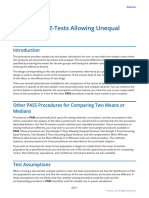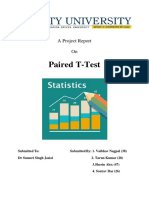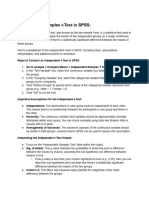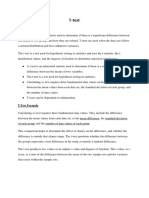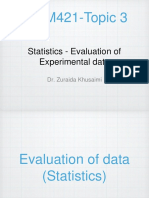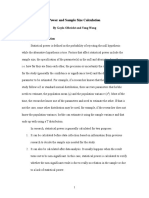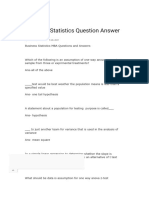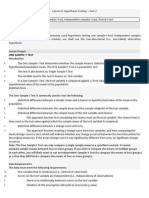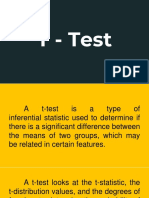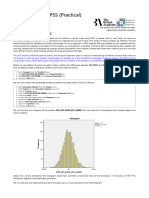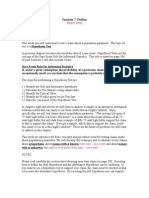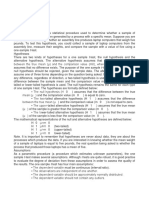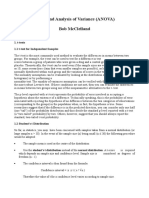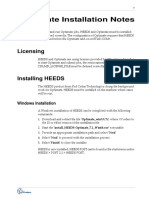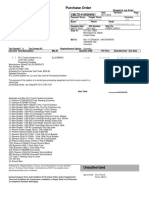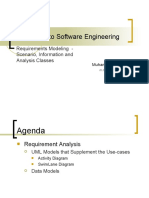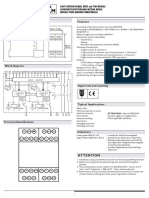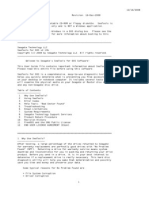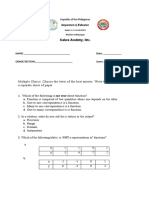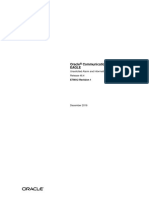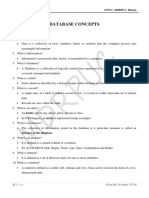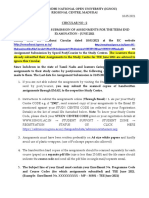New Microsoft Word Document
New Microsoft Word Document
Uploaded by
J T0 ratings0% found this document useful (0 votes)
26 views7 pagesCopyright
© © All Rights Reserved
Available Formats
DOCX, PDF, TXT or read online from Scribd
Share this document
Did you find this document useful?
Is this content inappropriate?
Report this DocumentCopyright:
© All Rights Reserved
Available Formats
Download as DOCX, PDF, TXT or read online from Scribd
Download as docx, pdf, or txt
0 ratings0% found this document useful (0 votes)
26 views7 pagesNew Microsoft Word Document
New Microsoft Word Document
Uploaded by
J TCopyright:
© All Rights Reserved
Available Formats
Download as DOCX, PDF, TXT or read online from Scribd
Download as docx, pdf, or txt
You are on page 1of 7
PASS Sample Size Software NCSS.com 485-1 © NCSS, LLC. All Rights Reserved.
Chapter 485 Paired T-
Tests Introduction The paired t-test may be used to test whether the mean difference of two
populations is greater than, less than, or not equal to 0. Because the t distribution is used to calculate
critical values for the test, this test is often called the paired t-test. The paired t-test assumes that the
population standard deviation of paired differences is unknown and will be estimated by the data. Other
PASS Procedures for Testing One Mean or Median from Paired Data Procedures in PASS are primarily
built upon the testing methods, test statistic, and test assumptions that will be used when the analysis
of the data is performed. You should check to identify that the test procedure described below in the
Test Procedure section matches your intended procedure. If your assumptions or testing method are
different, you may wish to use one of the other one-sample paired-data procedures available in PASS–
the Paired Z-Tests and the nonparametric Wilcoxon Signed-Rank Test procedures. The methods,
statistics, and assumptions for those procedures are described in the associated chapters. If you wish to
show that the mean of a population is larger (or smaller) than a reference value by a specified amount,
you should use one of the clinical superiority procedures for comparing means. Non-inferiority,
equivalence, and confidence interval procedures are also available. The Statistical Hypotheses In the
usual paired t-test setting with 𝛿𝛿 defined as the mean paired difference, the null (𝐻𝐻0) and alternative
(𝐻𝐻1) hypotheses for two-sided tests are defined as 𝐻𝐻0: 𝛿𝛿 = 0 versus 𝐻𝐻1: 𝛿𝛿 ≠ 0. Rejecting 𝐻𝐻0
implies that the mean paired difference is not equal to 0. The hypotheses for one-sided uppertail tests
are 𝐻𝐻0: 𝛿𝛿 ≤ 0 versus 𝐻𝐻1: 𝛿𝛿 > 0. Rejecting 𝐻𝐻0 implies that the mean is larger than the value 𝜇𝜇0.
This test is called an upper-tail test because 𝐻𝐻0 is rejected in samples in which the sample mean is
larger than 𝜇𝜇0. The lower-tail test is 𝐻𝐻0: 𝛿𝛿 ≥ 0 versus 𝐻𝐻1: 𝛿𝛿 < 0. PASS Sample Size Software
NCSS.com Paired T-Tests 485-2 © NCSS, LLC. All Rights Reserved. It will be convenient to adopt the
following specialized notation for the discussion of these tests. Parameter PASS Input/Output
Interpretation 𝛿𝛿 𝛿𝛿 Population mean paired difference. This is the mean of paired differences. This
parameter will be estimated by the study. 𝛿𝛿1 𝛿𝛿1 Actual paired difference at which power is
calculated. This is the value of the mean paired difference at which power is calculated. Test Procedure
1. Find the critical value. Assume that the true mean paired difference is 0. Choose a value 𝑇𝑇𝛼𝛼 so that
the probability of rejecting 𝐻𝐻0 when 𝐻𝐻0 is true is equal to a specified value called α. Using the t
distribution, select 𝑇𝑇𝛼𝛼 so that Pr(𝑡𝑡 > 𝑇𝑇𝛼𝛼) = 𝛼𝛼. This value is found using a t probability table or a
computer program (like PASS). 2. Select a sample of n items from the population and compute the t
statistic. Call this value T. If 𝑇𝑇 > 𝑇𝑇𝛼𝛼 reject the null hypothesis that the mean paired difference equals
0 in favor of an alternative hypothesis that the mean is greater than 0. Following is a specific example.
Suppose we want to test the hypothesis that a variable, X, which is made up of paired differences, has a
mean of 0 versus the alternative hypothesis that the mean is greater than 0. Suppose that previous
studies have shown that the standard deviation of the paired differences, 𝜎𝜎, is 40. A random sample of
100 pairs is used. We first compute the critical value, 𝑇𝑇𝛼𝛼. The value of 𝑇𝑇𝛼𝛼 that yields α = 0.05 is
6.6. If the paired mean difference computed from a sample is greater than 6.6, reject the hypothesis
that the mean is 0. Otherwise, do not reject the hypothesis. We call the region greater than 6.6 the
Rejection Region and values less than or equal to 6.6 the Acceptance Region of the significance test.
Figure 1 - Finding Alpha PASS Sample Size Software NCSS.com Paired T-Tests 485-3 © NCSS, LLC. All
Rights Reserved. Now suppose that you want to compute the power of this testing procedure. In order
to compute the power, we must specify an alternative value for the mean. We decide to compute the
power if the true mean difference were 10. Figure 2 shows how to compute the power in this case. The
power is the probability of rejecting 𝐻𝐻0 when the true mean is 10. Since we reject 𝐻𝐻0 when the
calculated mean difference is greater than 6.6, the probability of a Type-II error (called β) is given by the
dark, shaded area of the second graph. This value is 0.196. The power is equal to 1 – β or 0.804. Note
that there are 5 parameters that may be varied in this situation: the mean paired difference, standard
deviation of paired differences, alpha, power, and the sample size. Assumptions for Paired Tests This
section describes the assumptions that are made when you use one of these tests. The key assumption
relates to normality or non-normality of the data. One of the reasons for the popularity of the t-test is its
robustness in the face of assumption violation. However, if the assumptions are not met, the
significance levels and the power of the t-test may be invalidated. Unfortunately, in practice it often
happens that several assumptions are not met. Take the steps to check the assumptions before you
make important decisions based on these tests. Paired Z-Test Assumptions The assumptions of the
paired z-test are: 1. The data are continuous (not discrete). 2. The data, i.e., the differences for the
matched pairs, follow a normal probability distribution. 3. The sample of pairs is a simple random
sample from its population. Each individual in the population has an equal probability of being selected
in the sample. 4. The population standard deviation of paired differences is known. Paired T-Test
Assumptions The assumptions of the paired t-test are: 1. The data are continuous (not discrete). 2. The
data, i.e., the differences for the matched pairs, follow a normal probability distribution. 3. The sample
of pairs is a simple random sample from its population. Each individual in the population has an equal
probability of being selected in the sample. Figure 2 - Finding Power PASS Sample Size Software
NCSS.com Paired T-Tests 485-4 © NCSS, LLC. All Rights Reserved. Wilcoxon Signed-Rank Test
Assumptions The assumptions of the Wilcoxon signed-rank test are as follows (note that the difference
is between a data value and the hypothesized median or between the two data values of a pair): 1. The
differences are continuous (not discrete). 2. The distribution of each difference is symmetric. 3. The
differences are mutually independent. 4. The differences all have the same median. 5. The measurement
scale is at least interval. Limitations There are few limitations when using these tests. Sample sizes may
range from a few to several hundred. If your data are discrete with at least five unique values, you can
often ignore the continuous variable assumption. Perhaps the greatest restriction is that your data come
from a random sample of the population. If you do not have a random sample, your significance levels
will probably be incorrect. Paired T-Test Statistic The paired t-test assumes that the paired differences,
𝑋𝑋𝑖𝑖, are a simple random sample from a population of normally distributed difference values that all
have the same mean and variance. This assumption implies that the data are continuous, and their
distribution is symmetric. The calculation of the t-test proceeds as follows 𝑡𝑡𝑛𝑛−1 = 𝑋𝑋� 𝑠𝑠⁄√𝑛𝑛 where
𝑋𝑋� = ∑ 𝑋𝑋𝑖𝑖 𝑛𝑛 𝑖𝑖=1 𝑛𝑛 , 𝑠𝑠 = �∑ (𝑋𝑋𝑖𝑖 − 𝑋𝑋�) 𝑛𝑛 2 𝑖𝑖=1 𝑛𝑛 − 1 , The significance of the test statistic
is determined by computing the p-value. If this p-value is less than a specified level (usually 0.05), the
hypothesis is rejected. Otherwise, no conclusion can be reached. PASS Sample Size Software NCSS.com
Paired T-Tests 485-5 © NCSS, LLC. All Rights Reserved. Population Size This is the number of subjects in
the population. Usually, you assume that samples are drawn from a very large (infinite) population.
Occasionally, however, situations arise in which the population of interest is of limited size. In these
cases, appropriate adjustments must be made. When a finite population size is specified, the standard
deviation is reduced according to the formula: 𝜎𝜎′2 = �1 − 𝑛𝑛 𝑁𝑁� 𝜎𝜎2 where n is the sample size, N
is the population size, 𝜎𝜎 is the original standard deviation, and 𝜎𝜎′ is the new standard deviation. The
quantity n/N is often called the sampling fraction. The quantity �1 − 𝑛𝑛 𝑁𝑁� is called the finite
population correction factor. The Standard Deviation of Paired Differences (σ) If you have results from a
previous (or pilot) study, use the estimate of the standard deviation of paired differences, 𝜎𝜎, from the
study. Another reasonable (but somewhat rough) estimate of 𝜎𝜎 may be obtained using the range of
paired differences as 𝜎𝜎 = 𝑅𝑅𝑅𝑅𝑅𝑅𝑅𝑅𝑅𝑅 4 If you have estimates of the expected standard deviations
of the paired variables (𝜎𝜎1 and 𝜎𝜎2) and the Pearson correlation between the paired variables (𝜌𝜌),
the standard deviation of paired differences (𝜎𝜎) may be calculated using the equation 𝜎𝜎2 = 𝜎𝜎1 2 +
𝜎𝜎2 2 − 2𝜌𝜌𝜎𝜎1𝜎𝜎2 such that 𝜎𝜎 = �𝜎𝜎1 2 + 𝜎𝜎2 2 − 2𝜌𝜌𝜎𝜎1𝜎𝜎2 . If 𝜎𝜎1 = 𝜎𝜎2 = 𝜎𝜎𝑥𝑥, then this
formula reduces to 𝜎𝜎2 = 2𝜎𝜎𝑥𝑥 2(1 − 𝜌𝜌) such that 𝜎𝜎 = �2𝜎𝜎𝑥𝑥 2(1 − 𝜌𝜌) . PASS Sample Size
Software NCSS.com Paired T-Tests 485-6 © NCSS, LLC. All Rights Reserved. If you have an estimate of the
within-subject population standard deviation (𝜎𝜎𝑤𝑤), then 𝜎𝜎 may be calculated using the equation
𝜎𝜎2 = 2𝜎𝜎𝑤𝑤 2 such that 𝜎𝜎 = �2𝜎𝜎𝑤𝑤 2 . 𝜎𝜎𝑤𝑤 is often estimated by the square root of the within
mean square error (WMSE) from a repeated measures ANOVA. Power Calculation for the Paired T-Test
When the standard deviation is unknown, the power is calculated as follows for a directional alternative
(one-tailed test) in which 𝛿𝛿1 > 0. 1. Find 𝑡𝑡𝛼𝛼 such that 1 − 𝑇𝑇𝑑𝑑𝑑𝑑(𝑡𝑡𝛼𝛼) = 𝛼𝛼, where 𝑇𝑇𝑑𝑑𝑑𝑑(𝑡𝑡𝛼𝛼)
is the area under a central-t curve to the left of x and df = n – 1. 2. Calculate: 𝑋𝑋1 = 𝑡𝑡𝛼𝛼 𝜎𝜎 √𝑛𝑛 . 3.
Calculate the noncentrality parameter: 𝜆𝜆 = 𝛿𝛿1 𝜎𝜎 √𝑛𝑛 . 4. Calculate: 𝑡𝑡1 = 𝑋𝑋1−𝛿𝛿1 𝜎𝜎 √𝑛𝑛 + 𝜆𝜆. 5.
Power = 1 − 𝑇𝑇𝑑𝑑𝑑𝑑,𝜆𝜆 ′ (𝑡𝑡1), where 𝑇𝑇𝑑𝑑𝑑𝑑,𝜆𝜆 ′ (𝑥𝑥) is the area to the left of x under a noncentral-t
curve with degrees of freedom df and noncentrality parameter 𝜆𝜆. PASS Sample Size Software NCSS.com
Paired T-Tests 485-7 © NCSS, LLC. All Rights Reserved. Example 1 – Computing Power Usually, a
researcher designs a study to compare two or more groups of subjects, so the one sample case
described in this chapter occurs infrequently. However, there is a popular research design that does lead
to the single mean test: paired observations. For example, suppose researchers want to study the
impact of an exercise program on the individual’s weight. To do so they randomly select N individuals,
weigh them, put them through the exercise program, and weigh them again. The variable of interest is
not their actual weight, but how much their weight changed. In this design, the data are analyzed using
a one-sample t-test on the differences between the paired observations. The null hypothesis is that the
average difference is zero. The alternative hypothesis is that the average difference is some nonzero
value. To study the impact of an exercise program on weight loss, the researchers decide to conduct a
study that will be analyzed using the paired t-test. A sample of individuals will be weighed before and
after a specified exercise program that will last three months. The difference in their weights will be
analyzed. Past experiments of this type have had standard deviations in the range of 10 to 15 pounds.
The researcher wants to detect a difference of 5 pounds or more with an alpha of 0.05. What is the
power for sample sizes between 30 and 100? Setup If the procedure window is not already open, use
the PASS Home window to open it. The parameters for this example are listed below and are stored in
the Example 1 settings file. To load these settings to the procedure window, click Open Example Settings
File in the Help Center or File menu. Design Tab _____________
_______________________________________ Solve For .......................................................Power
Alternative Hypothesis ...................................Two-Sided (H1: δ ≠ 0) Population
Size..............................................Infinite Alpha..............................................................0.05 N (Sample
Size).............................................30 to 100 by 10 δ1 (Mean of Paired Differences)....................-5 Standard
Deviation Input Type ......................Enter the SD of Paired Differences σ (SD of Paired
Differences)..........................10 12.5 15 PASS Sample Size Software NCSS.com Paired T-Tests 485-8 ©
NCSS, LLC. All Rights Reserved. Output Click the Calculate button to perform the calculations and
generate the following output. Numeric Results
───────────────────────────────────────────────────────────────────────── Solve For:
Power Hypotheses: H0: δ = 0 vs. H1: δ ≠ 0
───────────────────────────────────────────────────────────────────────── Paired
Differences ─────────────── Sample Standard Effect Size Mean Deviation Size Power N δ1 σ |δ1|/σ
Alpha Beta
─────────────────────────────────────────────────────────────────────────────────────
──────────── 0.75396 30 -5 10.0 0.50000 0.05 0.24604 0.86940 40 -5 10.0 0.50000 0.05 0.13060
0.93390 50 -5 10.0 0.50000 0.05 0.06610 0.96779 60 -5 10.0 0.50000 0.05 0.03221 0.98478 70 -5 10.0
0.50000 0.05 0.01522 0.99300 80 -5 10.0 0.50000 0.05 0.00700 0.99685 90 -5 10.0 0.50000 0.05 0.00315
0.99861 100 -5 10.0 0.50000 0.05 0.00139 0.56281 30 -5 12.5 0.40000 0.05 0.43719 0.69399 40 -5 12.5
0.40000 0.05 0.30601 0.79179 50 -5 12.5 0.40000 0.05 0.20821 0.86162 60 -5 12.5 0.40000 0.05 0.13838
0.90984 70 -5 12.5 0.40000 0.05 0.09016 0.94225 80 -5 12.5 0.40000 0.05 0.05775 0.96355 90 -5 12.5
0.40000 0.05 0.03645 0.97730 100 -5 12.5 0.40000 0.05 0.02270 0.42291 30 -5 15.0 0.33333 0.05
0.57709 0.53833 40 -5 15.0 0.33333 0.05 0.46167 0.63709 50 -5 15.0 0.33333 0.05 0.36291 0.71898 60 -
5 15.0 0.33333 0.05 0.28102 0.78521 70 -5 15.0 0.33333 0.05 0.21479 0.83770 80 -5 15.0 0.33333 0.05
0.16230 0.87860 90 -5 15.0 0.33333 0.05 0.12140 0.91002 100 -5 15.0 0.33333 0.05 0.08998
───────────────────────────────────────────────────────────────────────── Power The
probability of rejecting a false null hypothesis when the alternative hypothesis is true. N The sample
size, the number of subjects (or pairs) in the study. δ The population mean of paired differences. δ1 The
value of the mean of paired differences at which power and sample size are calculated. σ The standard
deviation of paired differences for the population. |δ1|/σ The Effect Size, i.e., the relative magnitude of
the effect. Alpha The probability of rejecting a true null hypothesis. Beta The probability of failing to
reject the null hypothesis when the alternative hypothesis is true. Summary Statements
───────────────────────────────────────────────────────────────────────── A paired
design will be used to test whether the paired mean difference (δ) is different from 0 (H0: δ = 0 versus
H1: δ ≠ 0). The comparison will be made using a two-sided, paired-difference t-test, with a Type I error
rate (α) of 0.05. The underlying standard deviation of the paired difference distribution is assumed to be
10. To detect a paired mean difference of -5 with a sample size of 30 pairs, the power is 0.75396.
───────────────────────────────────────────────────────────────────────── PASS Sample
Size Software NCSS.com Paired T-Tests 485-9 © NCSS, LLC. All Rights Reserved. Dropout-Inflated Sample
Size ─────────────────────────────────────────────────────────────────────────
DropoutInflated Expected Enrollment Number of Sample Size Sample Size Dropouts Dropout Rate N N' D
───────────────────────────────────────────────────────────────────────────── 20% 30
38 8 20% 40 50 10 20% 50 63 13 20% 60 75 15 20% 70 88 18 20% 80 100 20 20% 90 113 23 20% 100 125
25 ───────────────────────────────────────────────────────────────────────── Dropout
Rate The percentage of subjects (or items) that are expected to be lost at random during the course of
the study and for whom no response data will be collected (i.e., will be treated as "missing").
Abbreviated as DR. N The evaluable sample size at which power is computed (as entered by the user). If
N subjects are evaluated out of the N' subjects that are enrolled in the study, the design will achieve the
stated power. N' The total number of subjects that should be enrolled in the study in order to obtain N
evaluable subjects, based on the assumed dropout rate. N' is calculated by inflating N using the formula
N' = N / (1 - DR), with N' always rounded up. (See Julious, S.A. (2010) pages 52-53, or Chow, S.C., Shao, J.,
Wang, H., and Lokhnygina, Y. (2018) pages 32-33.) D The expected number of dropouts. D = N' - N.
Dropout Summary Statements
───────────────────────────────────────────────────────────────────────── Anticipating a
20% dropout rate, 38 subjects should be enrolled to obtain a final sample size of 30 subjects.
───────────────────────────────────────────────────────────────────────── References
───────────────────────────────────────────────────────────────────────── Chow, S.C.,
Shao, J., Wang, H., and Lokhnygina, Y. 2018. Sample Size Calculations in Clinical Research, Third Edition.
Taylor & Francis/CRC. Boca Raton, Florida. Machin, D., Campbell, M., Fayers, P., and Pinol, A. 1997.
Sample Size Tables for Clinical Studies, 2nd Edition. Blackwell Science. Malden, MA. Zar, Jerrold H. 1984.
Biostatistical Analysis (Second Edition). Prentice-Hall. Englewood Cliffs, New Jersey.
───────────────────────────────────────────────────────────────────────── PASS Sample
Size Software NCSS.com Paired T-Tests 485-10 © NCSS, LLC. All Rights Reserved. Plots
───────────────────────────────────────────────────────────────────────── These reports
and plots show the relationship between sample size and power for various values of N and 𝜎𝜎. PASS
Sample Size Software NCSS.com Paired T-Tests 485-11 © NCSS, LLC. All Rights Reserved. Example 2 –
Finding the Sample Size Continuing with Example 1, how many pairs are required for each scenario to
achieve 80% power? Setup If the procedure window is not already open, use the PASS Home window to
open it. The parameters for this example are listed below and are stored in the Example 2 settings file.
To load these settings to the procedure window, click Open Example Settings File in the Help Center or
File menu. Design Tab _____________ _______________________________________ Solve
For .......................................................Sample Size Alternative Hypothesis ...................................Two-
Sided (H1: δ ≠ 0) Population Size..............................................Infinite
Power.............................................................0.8 Alpha..............................................................0.05 δ1
(Mean of Paired Differences)....................-5 Standard Deviation Input Type ......................Enter the SD of
Paired Differences σ (SD of Paired Differences)..........................10 12.5 15 Output Click the Calculate
button to perform the calculations and generate the following output. Numeric Results
───────────────────────────────────────────────────────────────────────── Solve For:
Sample Size Hypotheses: H0: δ = 0 vs. H1: δ ≠ 0
───────────────────────────────────────────────────────────────────────── Paired
Differences ─────────────── Sample Standard Effect Size Mean Deviation Size Power N δ1 σ |δ1|/σ
Alpha Beta
─────────────────────────────────────────────────────────────────────────────────────
──────────── 0.80778 34 -5 10.0 0.50000 0.05 0.19222 0.80779 52 -5 12.5 0.40000 0.05 0.19221
0.80230 73 -5 15.0 0.33333 0.05 0.19770
───────────────────────────────────────────────────────────────────────── The required
sample sizes for each scenario are displayed. PASS Sample Size Software NCSS.com Paired T-Tests 485-
12 © NCSS, LLC. All Rights Reserved. Example 3 – Validation using Chow, Shao, Wang, and Lokhnygina
(2018) Chow, Shao, Wang, and Lokhnygina (2018) presents an example on pages 45 and 46 of a two-
sided onesample t-test sample size calculation in which μ0 = 1.5, μ1 = 2.0, σ = 1.0, alpha = 0.05, and
power = 0.80. They obtain a sample size of 34. If we set δ1 = 2.0 – 1.5 = 0.5 then we should get the same
result because the one-sample t-test and the paired t-test use the same fundamental calculations. Setup
If the procedure window is not already open, use the PASS Home window to open it. The parameters for
this example are listed below and are stored in the Example 3 settings file. To load these settings to the
procedure window, click Open Example Settings File in the Help Center or File menu. Design Tab
_____________ _______________________________________ Solve
For .......................................................Sample Size Alternative Hypothesis ...................................Two-
Sided (H1: δ ≠ 0) Population Size..............................................Infinite
Power.............................................................0.8 Alpha..............................................................0.05 δ1
(Mean of Paired Differences)....................0.5 Standard Deviation Input Type ......................Enter the SD of
Paired Differences σ (SD of Paired Differences)..........................1 Output Click the Calculate button to
perform the calculations and generate the following output. Numeric Results
───────────────────────────────────────────────────────────────────────── Solve For:
Sample Size Hypotheses: H0: δ = 0 vs. H1: δ ≠ 0
───────────────────────────────────────────────────────────────────────── Paired
Differences ─────────────── Sample Standard Effect Size Mean Deviation Size Power N δ1 σ |δ1|/σ
Alpha Beta
─────────────────────────────────────────────────────────────────────────────────────
────────── 0.80778 34 0.5 1 0.5 0.05 0.19222
───────────────────────────────────────────────────────────────────────── The sample
size of 34 matches Chow, Shao, Wang, and Lokhnygina (2018) exactly. PASS Sample Size Software
NCSS.com Paired T-Tests 485-13 © NCSS, LLC. All Rights Reserved. Example 4 – Validation using Zar
(1984) Zar (1984) pages 111-112 presents an example in which δ1 = 1.0, σ = 1.25, alpha = 0.05, and N =
12. Zar obtains an approximate power of 0.72. Setup If the procedure window is not already open, use
the PASS Home window to open it. The parameters for this example are listed below and are stored in
the Example 4 settings file. To load these settings to the procedure window, click Open Example Settings
File in the Help Center or File menu. Design Tab _____________
_______________________________________ Solve For .......................................................Power
Alternative Hypothesis ...................................Two-Sided (H1: δ ≠ 0) Population
Size..............................................Infinite Alpha..............................................................0.05 N (Sample
Size).............................................12 δ1 (Mean of Paired Differences)....................1 Standard Deviation
Input Type ......................Enter the SD of Paired Differences σ (SD of Paired
Differences)..........................1.25 Output Click the Calculate button to perform the calculations and
generate the following output. Numeric Results
───────────────────────────────────────────────────────────────────────── Solve For:
Power Hypotheses: H0: δ = 0 vs. H1: δ ≠ 0
───────────────────────────────────────────────────────────────────────── Paired
Differences ─────────────── Sample Standard Effect Size Mean Deviation Size Power N δ1 σ |δ1|/σ
Alpha Beta
─────────────────────────────────────────────────────────────────────────────────────
────────── 0.71366 12 1 1.25 0.8 0.05 0.28634
───────────────────────────────────────────────────────────────────────── The
difference between the power computed by PASS of 0.71366 and the 0.72 computed by Zar is due to
Zar’s use of an approximation to the noncentral t distribution. PASS Sample Size Software NCSS.com
Paired T-Tests 485-14 © NCSS, LLC. All Rights Reserved. Example 5 – Validation using Machin (1997)
Machin, Campbell, Fayers, and Pinol (1997) page 37 presents an example in which δ1 = 0.2, σ = 1.0,
alpha = 0.05, and beta = 0.20. They obtain a sample size of 199. Setup If the procedure window is not
already open, use the PASS Home window to open it. The parameters for this example are listed below
and are stored in the Example 5 settings file. To load these settings to the procedure window, click Open
Example Settings File in the Help Center or File menu. Design Tab _____________
_______________________________________ Solve For .......................................................Sample Size
Alternative Hypothesis ...................................Two-Sided (H1: δ ≠ 0) Population
Size..............................................Infinite Power.............................................................0.8
Alpha..............................................................0.05 δ1 (Mean of Paired Differences)....................0.2
Standard Deviation Input Type ......................Enter the SD of Paired Differences σ (SD of Paired
Differences)..........................1 Output Click the Calculate button to perform the calculations and
generate the following output. Numeric Results
───────────────────────────────────────────────────────────────────────── Solve For:
Sample Size Hypotheses: H0: δ = 0 vs. H1: δ ≠ 0
───────────────────────────────────────────────────────────────────────── Paired
Differences ─────────────── Sample Standard Effect Size Mean Deviation Size Power N δ1 σ |δ1|/σ
Alpha Beta
─────────────────────────────────────────────────────────────────────────────────────
────────── 0.80169 199 0.2 1 0.2 0.05 0.19831
───────────────────────────────────────────────────────────────────────── The sample
size of 199 matches Machin’s result.
You might also like
- Example of Paired Sample TDocument3 pagesExample of Paired Sample TAkmal IzzairudinNo ratings yet
- Mann Whitney Wilcoxon Tests (Simulation)Document16 pagesMann Whitney Wilcoxon Tests (Simulation)scjofyWFawlroa2r06YFVabfbajNo ratings yet
- SAP Audit ManagementDocument35 pagesSAP Audit ManagementK Raghunatha ReddyNo ratings yet
- Paired T-Tests: Other PASS Procedures For Testing One Mean or Median From Paired DataDocument13 pagesPaired T-Tests: Other PASS Procedures For Testing One Mean or Median From Paired Datajay SinghNo ratings yet
- One-Sample Z-Tests: Other PASS Procedures For Testing One Mean or MedianDocument12 pagesOne-Sample Z-Tests: Other PASS Procedures For Testing One Mean or MedianRafi UllahNo ratings yet
- T Test Function in Statistical SoftwareDocument9 pagesT Test Function in Statistical SoftwareNur Ain HasmaNo ratings yet
- Common StatisticsDocument23 pagesCommon StatisticsJeffNo ratings yet
- Hypothesis Testing Vince ReganzDocument9 pagesHypothesis Testing Vince ReganzVince Edward RegañonNo ratings yet
- Thesis T TestDocument5 pagesThesis T Testh0nuvad1sif2100% (2)
- Statistics For A2 BiologyDocument9 pagesStatistics For A2 BiologyFaridOraha100% (1)
- Two-Sample Z-Tests Allowing Unequal VarianceDocument14 pagesTwo-Sample Z-Tests Allowing Unequal VarianceSumaiyaNo ratings yet
- Paired T-Test: A Project Report OnDocument19 pagesPaired T-Test: A Project Report OnTarun kumarNo ratings yet
- Bernard F Dela Vega PH 1-1Document5 pagesBernard F Dela Vega PH 1-1BernardFranciscoDelaVegaNo ratings yet
- Paired T Test Research PaperDocument6 pagesPaired T Test Research Paperzgkuqhxgf100% (1)
- The T-TestDocument3 pagesThe T-TestMarie TaylaranNo ratings yet
- Chapter 008-Data Analysis Techniques-UpdateDocument32 pagesChapter 008-Data Analysis Techniques-UpdateSuryanti TsangNo ratings yet
- Statistical TestsDocument11 pagesStatistical Testsluzviminda.dulayNo ratings yet
- PT Module5Document30 pagesPT Module5Venkat BalajiNo ratings yet
- CRJ 503 PARAMETRIC TESTS DifferencesDocument10 pagesCRJ 503 PARAMETRIC TESTS DifferencesWilfredo De la cruz jr.No ratings yet
- Allama Iqbal Open University Islamabad: Muhammad AshrafDocument25 pagesAllama Iqbal Open University Islamabad: Muhammad AshrafHafiz M MudassirNo ratings yet
- Lesson 5Document5 pagesLesson 5Vince DulayNo ratings yet
- Research MethodologyDocument23 pagesResearch MethodologynuravNo ratings yet
- Z Test FormulaDocument6 pagesZ Test FormulaE-m FunaNo ratings yet
- One Sample T Test - SPSSDocument23 pagesOne Sample T Test - SPSSManuel YeboahNo ratings yet
- Point Estimation of Process ParametersDocument64 pagesPoint Estimation of Process ParametersCharmianNo ratings yet
- T TestDocument6 pagesT TestsamprtNo ratings yet
- Data Science Interview Preparation (30 Days of Interview Preparation)Document27 pagesData Science Interview Preparation (30 Days of Interview Preparation)Satyavaraprasad BallaNo ratings yet
- Understanding Statistical Tests: Original ReportsDocument4 pagesUnderstanding Statistical Tests: Original ReportsDipendra Kumar ShahNo ratings yet
- SPSS AssignmentDocument6 pagesSPSS Assignmentaanya jainNo ratings yet
- Chapter 6Document6 pagesChapter 6Thakur RajendrasinghNo ratings yet
- CHM 421 - ToPIC 3 - StatisticsDocument58 pagesCHM 421 - ToPIC 3 - StatisticsthemfyNo ratings yet
- Power and Sample Size CalculationDocument13 pagesPower and Sample Size Calculationfranckiko2No ratings yet
- CH 11 - Small Sample TestDocument8 pagesCH 11 - Small Sample TesthehehaswalNo ratings yet
- Two Tailed & One TailedDocument5 pagesTwo Tailed & One TailedSefdy Then100% (1)
- Biostatistics NotesDocument6 pagesBiostatistics Notesdeepanjan sarkarNo ratings yet
- Common Statistical TestsDocument12 pagesCommon Statistical TestsshanumanuranuNo ratings yet
- L 11, One Sample TestDocument10 pagesL 11, One Sample TestShan AliNo ratings yet
- Business Statistics Question Answer MBA First Semester-1Document59 pagesBusiness Statistics Question Answer MBA First Semester-1charlieputh.130997No ratings yet
- Non-Normal Data Testing OptionsDocument16 pagesNon-Normal Data Testing OptionsFrancis Tallo (The Uniter)No ratings yet
- Minitab Hypothesis Testing PDFDocument7 pagesMinitab Hypothesis Testing PDFPadmakar29No ratings yet
- Unit 7 2 Hypothesis Testing and Test of DifferencesDocument13 pagesUnit 7 2 Hypothesis Testing and Test of Differencesedselsalamanca2No ratings yet
- Biostat W9Document18 pagesBiostat W9Erica Veluz LuyunNo ratings yet
- T - TestDocument45 pagesT - TestShiela May BoaNo ratings yet
- One Tailed and Two Tailed TestingDocument7 pagesOne Tailed and Two Tailed Testingnimra rafi100% (1)
- Inferential Statistics For Data ScienceDocument10 pagesInferential Statistics For Data Sciencersaranms100% (1)
- T-Test MaterialDocument10 pagesT-Test Materialhakimnguyen08No ratings yet
- Premili DefinitionsDocument3 pagesPremili DefinitionsJayakumar ChenniahNo ratings yet
- Statistical Analysis 3: Paired T-Test: Research Question TypeDocument4 pagesStatistical Analysis 3: Paired T-Test: Research Question TypeRetno Tri Astuti RamadhanaNo ratings yet
- Paired T Tests - PracticalDocument3 pagesPaired T Tests - PracticalMosesNo ratings yet
- Seminar 5 OutlineDocument4 pagesSeminar 5 Outlinejeremydb77No ratings yet
- Student's T Test: Ibrahim A. Alsarra, PH.DDocument20 pagesStudent's T Test: Ibrahim A. Alsarra, PH.DNana Fosu YeboahNo ratings yet
- Test Formula Assumption Notes Source Procedures That Utilize Data From A Single SampleDocument12 pagesTest Formula Assumption Notes Source Procedures That Utilize Data From A Single SamplesitifothmanNo ratings yet
- Z TestDocument18 pagesZ TestmelprvnNo ratings yet
- Types of T-Tests: Test Purpose ExampleDocument5 pagesTypes of T-Tests: Test Purpose Exampleshahzaf50% (2)
- MathDocument24 pagesMathNicole Mallari MarianoNo ratings yet
- AnnovaDocument4 pagesAnnovabharticNo ratings yet
- Selected Topics in Inferential Statistics: Janette C. LagosDocument75 pagesSelected Topics in Inferential Statistics: Janette C. LagosjanetteNo ratings yet
- Edar M-4Document47 pagesEdar M-4sknihal.cseNo ratings yet
- An Introduction To T-TestsDocument5 pagesAn Introduction To T-Testsbernadith tolinginNo ratings yet
- Sample Size for Analytical Surveys, Using a Pretest-Posttest-Comparison-Group DesignFrom EverandSample Size for Analytical Surveys, Using a Pretest-Posttest-Comparison-Group DesignNo ratings yet
- Installation NotesDocument4 pagesInstallation NotesLivingstone Ray MokiseNo ratings yet
- BEP 600-TLM-N Contour Matrix Tank Monitor: Installation AND Operating InstructionsDocument16 pagesBEP 600-TLM-N Contour Matrix Tank Monitor: Installation AND Operating InstructionsHaider FaresNo ratings yet
- Dlv04.02 - Analysis of Interoperability ChallengesDocument32 pagesDlv04.02 - Analysis of Interoperability ChallengesJán MičíkNo ratings yet
- Lec 8Document39 pagesLec 8Akram TaNo ratings yet
- Digital Signal Processing MCQ PDFDocument6 pagesDigital Signal Processing MCQ PDFWambi DanielcollinsNo ratings yet
- Introduction To Database SecurityDocument38 pagesIntroduction To Database SecurityHoàng Đình Hạnh100% (1)
- Shafiq Haqime ResumeDocument1 pageShafiq Haqime ResumeMUHAMMAD SHAFIQ HAQIME MOHD ISANo ratings yet
- Eritech System 2000Document64 pagesEritech System 2000Bagus Prahoro Tristantio100% (1)
- Queue Types: 1024Kb 0.8 819kibDocument3 pagesQueue Types: 1024Kb 0.8 819kibkalelNo ratings yet
- Microsoft Azure AZ 900 NotesDocument8 pagesMicrosoft Azure AZ 900 Notesmohan SNo ratings yet
- 6es7407 0KR02 0aa0Document3 pages6es7407 0KR02 0aa0Hammad AshrafNo ratings yet
- Purchase Order Drummond LTD.: Mina Pribbenow Dispatch Via PrintDocument3 pagesPurchase Order Drummond LTD.: Mina Pribbenow Dispatch Via PrintAnonymous CD0suI9No ratings yet
- Lecture 13 - Requirements Modeling - Scenario, Information and Analysis ClassesDocument35 pagesLecture 13 - Requirements Modeling - Scenario, Information and Analysis ClassesSufyan AbbasiNo ratings yet
- Ab MSR22LM PsdiDocument12 pagesAb MSR22LM PsdimalaquiascefetNo ratings yet
- How To Lay Out A Web Page With CSS: Adobe Dreamweaver GuideDocument5 pagesHow To Lay Out A Web Page With CSS: Adobe Dreamweaver GuideOking EnofnaNo ratings yet
- 0/1 Knapsack Algorithm Comparison: Jacek Dzikowski Illinois Institute of Technology E-Mail: Dzikjac@iit - EduDocument15 pages0/1 Knapsack Algorithm Comparison: Jacek Dzikowski Illinois Institute of Technology E-Mail: Dzikjac@iit - EduskimdadNo ratings yet
- Oracle Fusion General NotesDocument14 pagesOracle Fusion General NotesDevaraj Narayanan100% (1)
- Sea Tools Dos GuideDocument18 pagesSea Tools Dos GuidemarcE20102010No ratings yet
- B777 GPS IssuesDocument337 pagesB777 GPS Issuespierph738No ratings yet
- Assessment Grade 11Document4 pagesAssessment Grade 11Shout Out DacanhighNo ratings yet
- VideoDocument1 pageVideoJamal AbdullahNo ratings yet
- All Office TNADocument68 pagesAll Office TNAjohncaulfieldNo ratings yet
- Uam Uim STPDocument811 pagesUam Uim STPfouad boutatNo ratings yet
- Merlin Gerin Powerpact 4 Panelboards TechnicalDocument20 pagesMerlin Gerin Powerpact 4 Panelboards TechnicalxnurfzNo ratings yet
- Chapter 13 Database Concepts PDFDocument15 pagesChapter 13 Database Concepts PDFBala RamaNo ratings yet
- Powerline 500 Wifi Access PointDocument2 pagesPowerline 500 Wifi Access PointAriel Martinez NNo ratings yet
- Assignments For TEE June 2021 - Circular No. 2Document5 pagesAssignments For TEE June 2021 - Circular No. 2Shajith SudhakaranNo ratings yet
- Torque SpecificationsDocument50 pagesTorque SpecificationsNilton sergio gomes lins100% (1)










